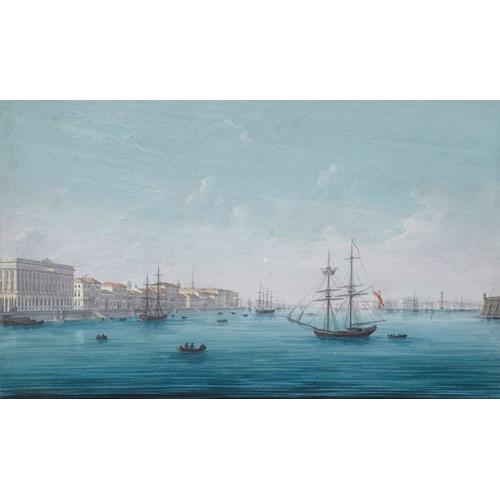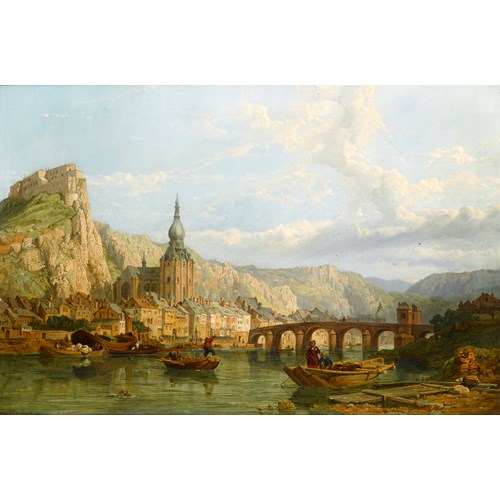Marketplace
A Landscape with a Convoy on a Wooded Track under Attack
Sebastian Vrancx
A Landscape with a Convoy on a Wooded Track under Attack
Period 1600-1750, 17th century
Origin Belgium
Medium Oil on panel
Dimension 44 x 64 cm (17³/₈ x 25¹/₄ inches)
Sebastian Vrancx was one of the first artists in the Netherlands to attempt battle scenes and A Landscape with Convoy on a Wooded Track under Attack offers an excellent example of his work. A wagon is under attack from bandits who have been hiding in the undergrowth on the right-hand side of the painting. The wagon has stopped as its driver flees for the safety of the bushes, whilst its occupants are left stranded inside. The wagon is guarded by three soldiers on horseback but in their startled state none have managed to engage their attackers. A line of bandits emerge from their hiding place and circle behind and around their victims, thus adding further to the confusion. Two figures remain in the bushes to provide covering fire and above them, perched in a tree, is one of their companions who has been keeping watch for the convoy and now helps to direct the attack. The scene is set in a softly coloured and brightly-lit landscape, which contrasts with the darker theme of the painting.
Attack of Robbers, another scene of conflict, in the Hermitage, also possesses the decorative qualities and Vrancx’s typically poised figures, just as in A Landscape with a Convoy on a Wooded Track under Attack. A clear narrative, with travellers on horses attempting to ward off robbers, creates a personal and absorbing image. It once more reveals Vrancx’s delight in detailing his paintings with the dynamic qualities that make his compositions appealing on both an aesthetic and historical level.
The two works portray incidents of violent ambush that were all too common in Vrancx’s time. As Geoffrey Parker notes, ‘most military actions of the early modern period involved relatively few troops; many of them also involved civilians’ and this is reflected by the helplessness of the civilian victims in these paintings, a recurring theme in Vrancx’s work.¹
These two works depict small surprise attacks populated by relatively few figures and the violence is one-sided in its nature. However, Vrancx also painted military battle scenes which are heavily populated and depict the clashes of large armies, an example being the Hermitage’s Battle Scene. Although it is considerably more hectic than A Landscape with Convoy on a Wooded Track under Attack, the Hermitage’s work has comparable features. In both works Vrancx depicts the variety of emotions and actions that are brought about by violence and so the figures engross the viewers’ attention. Both works are additionally set in panoramic landscapes and the restrained palettes are enlivened by splashes of red.
Born in Antwerp, it seems probable that Vrancx was trained in the workshop of Adam van Noort (1561-1641), under whom Peter Paul Rubens (1577-1640) also studied. Vrancx started to paint small-scale cavalry scenes early in his career and over half his oeuvre is devoted to battle scenes. He became an officer in the Antwerp Civic Guard in 1613 and eight years later was made a captain. It was no doubt this first-hand military experience that formed his interest and skill in the depiction of cavalry engagements and the battles of the Dutch wars, leading him to become a key figure in the development of such subjects.
However, Vrancx was an extremely versatile painter and also painted palace architecture, with groups of distinguished people enjoying themselves, allegorical scenes and landscapes. In this latter genre his Avenue with Trees and a Country House (Kunsthalle, Hamburg) is particularly noteworthy as it was echoed by Meindert Hobbema’s (1638-1709) famous Avenue at Middelharnis (1689, National Gallery, London).
Vrancx often collaborated with other artists, providing staffage for painters including Joos de Momper (1564-1635), Jan Brueghel I (1568-1625) and Pieter Neefs the Elder (1578?-c.1656/61). His influence on the genre of battle painting was considerable; in the southern Netherlands he was followed by Pieter Meulener (1602-1654), and in France by Adam-Frans van der Meulen (1632-1690). In the northern Netherlands Vrancx’s influence can be seen clearly in the work of Esaias van de Velde (1587-1630) and Pauwels van Hillegaert (1595/6-1640).
We are grateful to Willem van de Watering for confirming the attribution, having examined the work in the original.
¹ Parker, G., The Cambridge Illustrated History of Warfare, (Cambridge University Press, 2008), p. 158.
Attack of Robbers, another scene of conflict, in the Hermitage, also possesses the decorative qualities and Vrancx’s typically poised figures, just as in A Landscape with a Convoy on a Wooded Track under Attack. A clear narrative, with travellers on horses attempting to ward off robbers, creates a personal and absorbing image. It once more reveals Vrancx’s delight in detailing his paintings with the dynamic qualities that make his compositions appealing on both an aesthetic and historical level.
The two works portray incidents of violent ambush that were all too common in Vrancx’s time. As Geoffrey Parker notes, ‘most military actions of the early modern period involved relatively few troops; many of them also involved civilians’ and this is reflected by the helplessness of the civilian victims in these paintings, a recurring theme in Vrancx’s work.¹
These two works depict small surprise attacks populated by relatively few figures and the violence is one-sided in its nature. However, Vrancx also painted military battle scenes which are heavily populated and depict the clashes of large armies, an example being the Hermitage’s Battle Scene. Although it is considerably more hectic than A Landscape with Convoy on a Wooded Track under Attack, the Hermitage’s work has comparable features. In both works Vrancx depicts the variety of emotions and actions that are brought about by violence and so the figures engross the viewers’ attention. Both works are additionally set in panoramic landscapes and the restrained palettes are enlivened by splashes of red.
Born in Antwerp, it seems probable that Vrancx was trained in the workshop of Adam van Noort (1561-1641), under whom Peter Paul Rubens (1577-1640) also studied. Vrancx started to paint small-scale cavalry scenes early in his career and over half his oeuvre is devoted to battle scenes. He became an officer in the Antwerp Civic Guard in 1613 and eight years later was made a captain. It was no doubt this first-hand military experience that formed his interest and skill in the depiction of cavalry engagements and the battles of the Dutch wars, leading him to become a key figure in the development of such subjects.
However, Vrancx was an extremely versatile painter and also painted palace architecture, with groups of distinguished people enjoying themselves, allegorical scenes and landscapes. In this latter genre his Avenue with Trees and a Country House (Kunsthalle, Hamburg) is particularly noteworthy as it was echoed by Meindert Hobbema’s (1638-1709) famous Avenue at Middelharnis (1689, National Gallery, London).
Vrancx often collaborated with other artists, providing staffage for painters including Joos de Momper (1564-1635), Jan Brueghel I (1568-1625) and Pieter Neefs the Elder (1578?-c.1656/61). His influence on the genre of battle painting was considerable; in the southern Netherlands he was followed by Pieter Meulener (1602-1654), and in France by Adam-Frans van der Meulen (1632-1690). In the northern Netherlands Vrancx’s influence can be seen clearly in the work of Esaias van de Velde (1587-1630) and Pauwels van Hillegaert (1595/6-1640).
We are grateful to Willem van de Watering for confirming the attribution, having examined the work in the original.
¹ Parker, G., The Cambridge Illustrated History of Warfare, (Cambridge University Press, 2008), p. 158.
Period: 1600-1750, 17th century
Origin: Belgium
Medium: Oil on panel
Dimension: 44 x 64 cm (17³/₈ x 25¹/₄ inches)
More artworks from the Gallery









